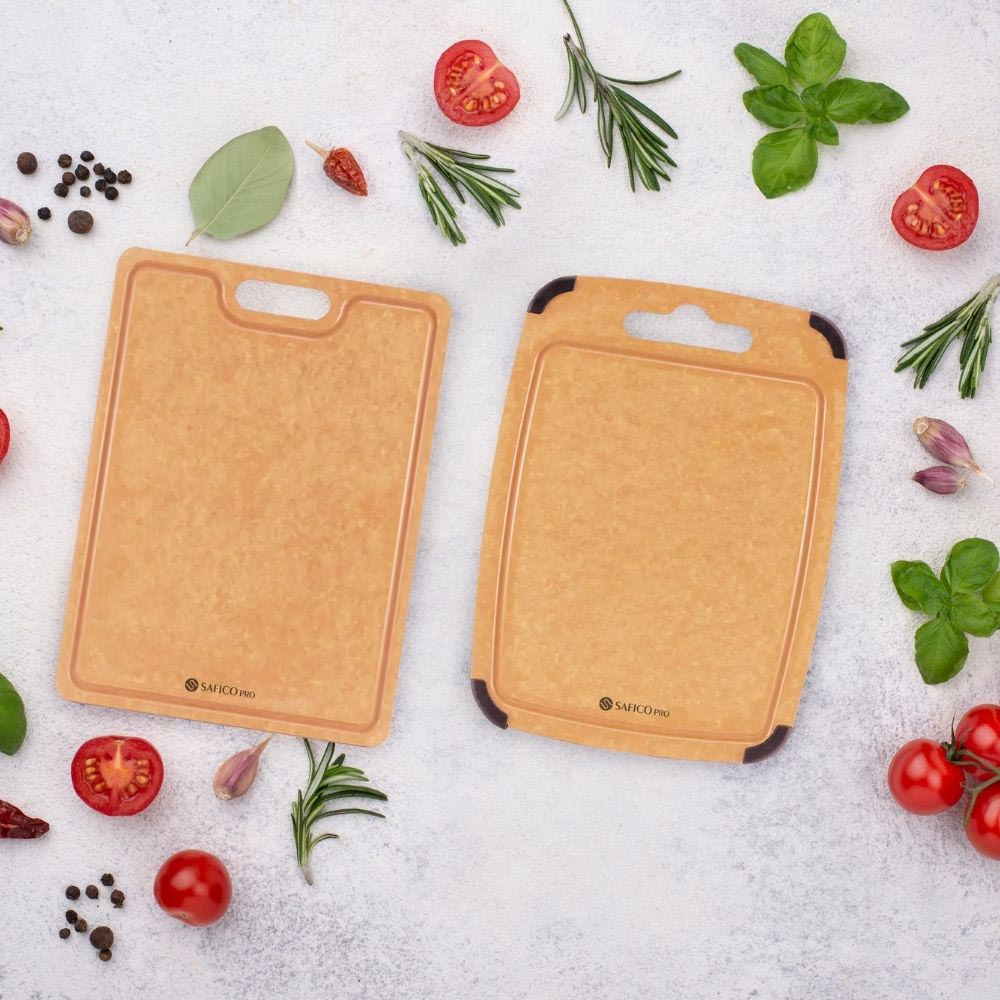Plastic Cutting Boards
There are many different types of plastic cutting boards in the market. But what do we really know about them?
High-Density Polyethylene (HDPE) Cutting Boards:
High-density polyethylene (HDPE) is a type of plastic formed from long, chained molecules. This structure grants HDPE several advantages that make it a popular choice for cutting boards. Its impressive strength-to-weight ratio translates to a durable board resistant to chipping, cracking, peeling, and warping. Unlike softer plastics, HDPE can handle everyday kitchen use without deforming.
HDPE, as with all plastic cutting boards that we will be discussing in this article, is dishwasher safe and has a non-porous surface, which is a key factor in preventing bacteria growth. This makes them a hygienic choice for handling raw meat and poultry.
However, there are trade-offs to consider. Continued use of HDPE boards can slightly dull your knives over time, although proper care and technique can minimize this effect.
While resistant to major damage, the surface of HDPE can develop scratches and gouges that can harbour food and bacteria. When this happens, you can use a cutting board scraper to remove the top layer, restoring the board to a like-new appearance.
Medium-Density Cutting Boards:
Medium-density cutting boards are made of long, chain-like molecules with air pockets between them. This provides a balance between flexibility and durability, offering good impact resistance and reducing the likelihood of cracking or shattering if dropped.
The slight give in medium-density boards allows them to absorb some of the impact from knife blades, which helps to reduce the depth of cuts and scratches compared to more rigid materials like high-density polyethylene (HDPE). This cushioning effect not only helps maintain the board’s surface but also reduces wear on the knife edge, keeping it sharper for a longer time.
Some medium-density cutting boards are manufactured thicker than their high-density counterparts to compensate for the material’s flexibility, resulting in a sturdier and more reliable cutting surface, albeit a bulkier board.
Low-density cutting boards are characterized by their lighter weight and softer surface compared to higher-density options. This makes them more knife-friendly but also more susceptible to scratches and cuts. While affordable, they are best suited for situations that don’t require heavy-duty use.
Co-Polymer Blend Cutting Boards:
A co-polymer blend is created by combining two or more different types of polymers to achieve properties that a single polymer alone cannot provide. For cutting boards, this blend results in a surface that is both gentle on knives and durable enough for regular use, while also being warp-resistant.
Some co-polymer cutting boards in the market feature additional elements – such as an S-hook for hanging storage and for holding the board without touching the ingredients, a moulded-in ruler for uniform cuts, and anti-slip grip corners to keep the board securely in place.
For those using cutting boards without built-in anti-slip features, avoid using a wet towel as a makeshift anti-slip solution, as it can harbour bacteria and compromise food safety. Opt for a dedicated safety mat instead.
Colour-Coding:
Plastic boards are particularly effective for colour-coding due to their non-porous surface, which allows for the use of stable, non-reactive dyes. This feature makes it easy to assign specific colours to different food types—such as red for raw meat, yellow for poultry, green for vegetables, and purple for guests with food allergies—helping to prevent cross-contamination.
Kitchens can use training charts that clearly outline which colour corresponds to each food type. These charts serve as a quick reference for staff, ensuring that everyone adheres to the color-coding system consistently and maintains high standards of hygiene.




Wooden Cutting Boards
Wooden cutting boards are valued for their durability, aesthetic appeal, and knife-friendly surface. Their natural fibres help the board “self-heal” minor cuts, reducing bacteria buildup.
However, their porous nature allows moisture and food particles to seep in, creating an environment where bacteria can thrive. Unlike plastic options, wooden boards are not dishwasher safe. Nevertheless, with proper care such as regular cleaning, drying, and oiling, wooden cutting boards will last for years to come.
Rubber Lacquered Wooden Cutting Boards:
The combination of natural wood beauty and a protective rubber coating makes this cutting board a standout choice. The coating provides a smooth surface that protects your knives and reduces warping and cracking caused by moisture.
However, while lacquer is a tough coating, it’s not invincible. Constant use, harsh cleaning methods, or exposure to extreme temperatures can damage the lacquer itself. Gentle cleaning and occasional oiling (for the rubber) help maintain the integrity of the lacquer, maximizing its protective abilities and extending the lifespan of the board.
While pricier and heavier than some options, careful upkeep maximizes its lifespan and hygiene benefits.
Wooden fibre cutting boards are a modern and eco-friendly alternative to traditional wood. Made from compressed wood fibres, these boards are durable, resistant to warping, and require minimal maintenance. Unlike solid wood, their dense structure reduces moisture absorption.
While porous, wooden fibre boards can still be coloured by incorporating pigments into the wood fibre mixture before compression. Some boards feature dual-coloured sides, so cooks can differentiate between sides for different food types.
Lightweight yet sturdy, wooden fibre boards are often more budget-friendly than solid wood, and easy to clean without the need for oiling, simplifying upkeep. However, they may scratch more easily than plastic options.
Asian Style Solid Wooden Chopping Boards:
Made from solid wood, these chopping boards are built to withstand heavy-duty tasks like chopping through large cuts of meat and vegetables. Their thickness ensures stability during forceful cuts, while the solid wood construction contributes to their longevity.
One obvious drawback is their weight, which makes them more cumbersome to handle and clean. They also typically come with a higher price tag compared to thinner or synthetic boards. Despite these trade-offs, their durability and reliability have made them a preferred choice among serious cooks in Asian kitchens.




